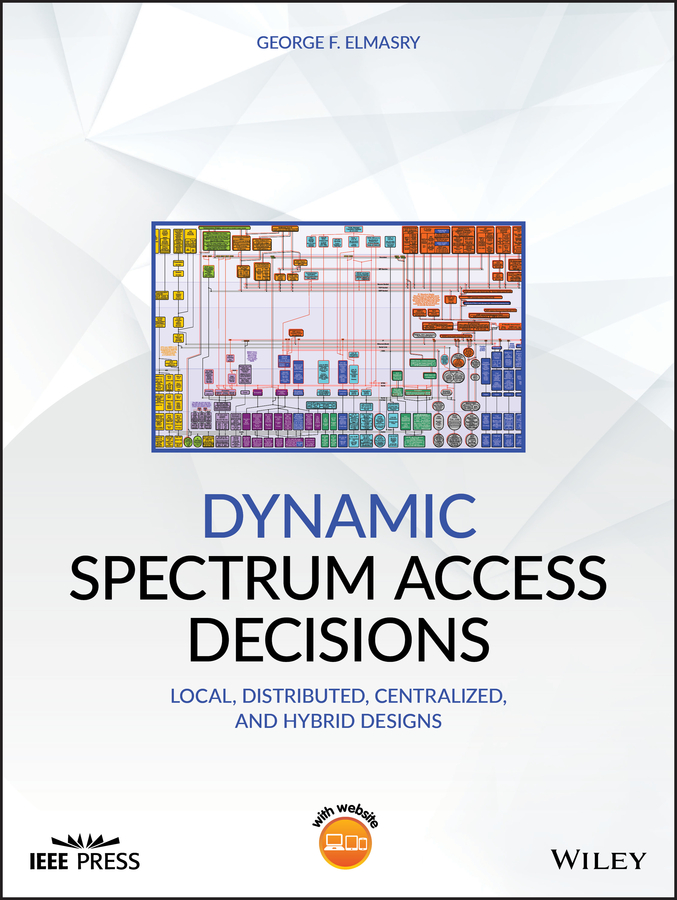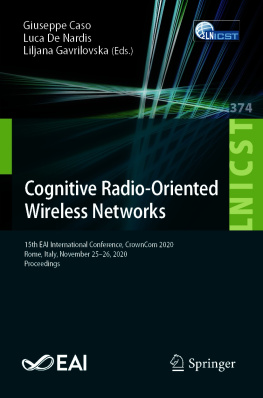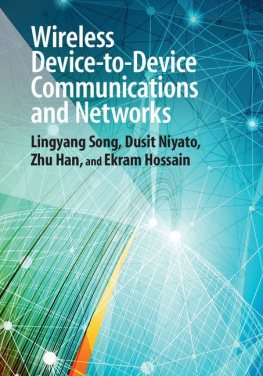
Table of Contents
List of Tables
- Chapter 2
- Chapter 3
- Chapter 6
- Chapter 8
- Chapter 12
- Chapter 13b
- Chapter 13d
- Chapter 13e
- Chapter 14
- Chapter 15
- c16
- Chapter 17
- Chapter 18
- Chapter 19
List of Illustrations
- Chapter 1
- Chapter 2
- Chapter 3
- Chapter 4
- Chapter 5
- Chapter 6
- Chapter 7
- Chapter 8
- Chapter 9
- Chapter 10
- Chapter 11
- Chapter 12
- Chapter 13
- Chapter 13a
- Chapter 13c
- Chapter 13e
- Chapter 14
- Chapter 15
- c16
- Chapter 17
- Chapter 18
- Chapter 19
Guide
Pages
Dynamic Spectrum Access Decisions
Local, Distributed, Centralized, and Hybrid Designs
George F. Elmasry
Rockwell Collins Advanced Technology Center
USA

Copyright
This edition first published 2021
2021 John Wiley & Sons Ltd
All rights reserved. No part of this publication may be reproduced, stored in a retrieval system, or transmitted, in any form or by any means, electronic, mechanical, photocopying, recording or otherwise, except as permitted by law. Advice on how to obtain permission to reuse material from this title is available at http://www.wiley.com/go/permissions.
The right of George F. Elmasry to be identified as the author of this work has been asserted in accordance with law.
Registered Offices
John Wiley & Sons, Inc., 111 River Street, Hoboken, NJ 07030, USA
John Wiley & Sons Ltd, The Atrium, Southern Gate, Chichester, West Sussex, PO19 8SQ, UK
Editorial Office
The Atrium, Southern Gate, Chichester, West Sussex, PO19 8SQ, UK
For details of our global editorial offices, customer services, and more information about Wiley products visit us at www.wiley.com.
Wiley also publishes its books in a variety of electronic formats and by printondemand. Some content that appears in standard print versions of this book may not be available in other formats.
Limit of Liability/Disclaimer of Warranty
While the publisher and authors have used their best efforts in preparing this work, they make no representations or warranties with respect to the accuracy or completeness of the contents of this work and specifically disclaim all warranties, including without limitation any implied warranties of merchantability or fitness for a particular purpose. No warranty may be created or extended by sales representatives, written sales materials or promotional statements for this work. The fact that an organization, website, or product is referred to in this work as a citation and/or potential source of further information does not mean that the publisher and authors endorse the information or services the organization, website, or product may provide or recommendations it may make. This work is sold with the understanding that the publisher is not engaged in rendering professional services. The advice and strategies contained herein may not be suitable for your situation. You should consult with a specialist where appropriate. Further, readers should be aware that websites listed in this work may have changed or disappeared between when this work was written and when it is read. Neither the publisher nor authors shall be liable for any loss of profit or any other commercial damages, including but not limited to special, incidental, consequential, or other damages.
Library of Congress CataloginginPublication Data
Names: Elmasry, George F., author.
Title: Dynamic spectrum access decisions : local, distributed, centralized,
and hybrid designs / George F. Elmasry.
Description: Hoboken, NJ, USA : Wiley, 2020. | Includes bibliographical
references and index.
Identifiers: LCCN 2020017306 (print) | LCCN 2020017307 (ebook) | ISBN
9781119573760 (hardback) | ISBN 9781119573777 (adobe pdf) | ISBN
9781119573791 (epub)
Subjects: LCSH: Radio resource management (Wireless communications) |
Cognitive radio networks.
Classification: LCC TK5103.4873 .E46 2020 (print) | LCC TK5103.4873
(ebook) | DDC 621.384dc23
LC record available at https://lccn.loc.gov/2020017306
LC ebook record available at https://lccn.loc.gov/2020017307
Cover Design: Wiley
Cover Images: Spectrum access tools hybrid design courtesy of James Stevens, Abstract background StudioPro/Getty Images
I would like to thank the IEEE for allowing the DySPANSC material to be included in this book. I also would like to thank Dr. James Stevens, the networking fellow at Collins Aerospace, and Dr. Thomas Tapp, the product owner of DSA capabilities at Collins Aerospace for their valuable input to this book. The DySPANSC material made this book a comprehensive reference for engineers developing DSA systems and Dr. Stevens's and Dr. Tapp's reviews and suggestions added so much value to this text.
About the Author
Dr. George F. Elmasry was born in Egypt and received a Bachelor of Science in Electrical Engineering and Electrophysics from Alexandria University, Egypt in 1985. He then went on to receive a Master of Science and a PhD in Electrical Engineering from the New Jersey Institute of Technology (NJIT) in 1993 and 1999, respectively. Dr. Elmasry has over 25 years of industrial experience in commercial and defense telecommunications and is currently part of the Advanced Technology Center of Collins Aerospace, which is a forwardlooking research and development organization for defense and commercial aerospace telecommunications systems.
Dr. Elmasry has an interdisciplinary background in electrical and computer engineering and computer science. He is active in research, patenting, publications, grant proposals as well as system engineering of defense and commercial aerospace wireless communications systems. He has experience with technical task leads, team building and management. Dr. Elmasry has over 50 peerreviewed publications and countless patents that pertain to network resource management, network management, network operation, software defined radios, cognitive networking, resilient communications and network and transport layers algorithms.
Dr. Elmasry has authored a book on tactical wireless communications and networking that has been used as a textbook for graduate and senior level courses in different universities in the United States and internationally. He also authored part of the McGrawHill encyclopedia on the history of military radios.
In addition to his publications and patents activities, Dr. Elmasry has been a technical member of the annual Military Communications Conference (MILCOM) since 2003, where he has participated in session organization, paper reviews and session chairing. Dr. Elmasry is also a senior member of the Institute of Electrical and Computer Engineering (IEEE), a member of the Armed Forces Communications and Electronics Association (AFCEA) International, a Member of Sigma Xi and a member of Alpha Epsilon Lambda, the NJIT graduatestudent honor society. Dr. Elmasry holds countless awards, including the prestigious Hashimoto Award for achievement and academic excellence in electrical and computer engineering.
Preface
The coupling of spectrum sensing and dynamic spectrum access (DSA) solely with cognitive radios can do a disservice to the wireless communications community. Long before the concept of cognitive radios was coined, the defense community had elaborate spectrum sensing techniques. Since World War II, the defense community have had signal intelligence (SigInt) capabilities that are decades ahead of the commercial world's sensing capabilities. In today's commercial wireless system, we have the concept of finding the geolocation of a spectrum emitter through using multiple receivers (sensors) that can estimate the geolocation of the emitter and the direction of the emitter's beam. The defense community had this concept implemented in SigInt decades before the commercial world understood it and without having preknowledge of the emitted signal characteristics. SigInt capabilities used spectrum sensors extensively as part of the catandmouse game of detecting the enemy's spectrum emission and overcoming the enemy's jammers.
Next page









